wheel TOYOTA SEQUOIA 2021 Owners Manual (in English)
[x] Cancel search | Manufacturer: TOYOTA, Model Year: 2021, Model line: SEQUOIA, Model: TOYOTA SEQUOIA 2021Pages: 588, PDF Size: 12.76 MB
Page 2 of 588

TABLE OF CONTENTS2
SEQUOIA_OM_USA_OM0C035UFor your information....................... 8
Reading this manual .................... 14
How to search .............................. 15
Pictorial index .............................. 16
1-1. For safe use
Before driving ...................... 26
For safe driving ................... 28
Seat belts ............................ 30
SRS airbags ........................ 40
Front passenger occupant classification system ......... 51
Safety information for children ............................. 57
Child restraint systems ........ 58
Installing child restraints ...... 62
Exhaust gas precautions ..... 75
1-2. Emergency assistance Safety Connect.................... 76
1-3. Theft deterrent system Engine immobilizer system............................... 82
Alarm ................................... 84
2. Instrument cluster Warning lights and indicators........................... 88
Gauges and meters............. 94
Multi-information display ..... 98
Fuel consumption information ...................... 104 3-1. Key information
Keys................................... 108
3-2. Opening, closing and locking the doors
Side doors ......................... 113
Back door .......................... 118
Smart key system .............. 128
3-3. Adjusting the seats Front seats......................... 136
Rear seats ......................... 138
Driving position memory .... 149
Head restraints .................. 154
3-4. Adjusting the steering wheel and mirrors
Steering wheel ................... 156
Inside rear view mirror ....... 158
Outside rear view mirrors ............................. 161
3-5. Opening, closing the windows and
moon roof
Power windows.................. 165
Power back window ........... 168
Moon roof .......................... 171
1For safety and security
2Instrument cluster
3Operation of
each component
Page 3 of 588
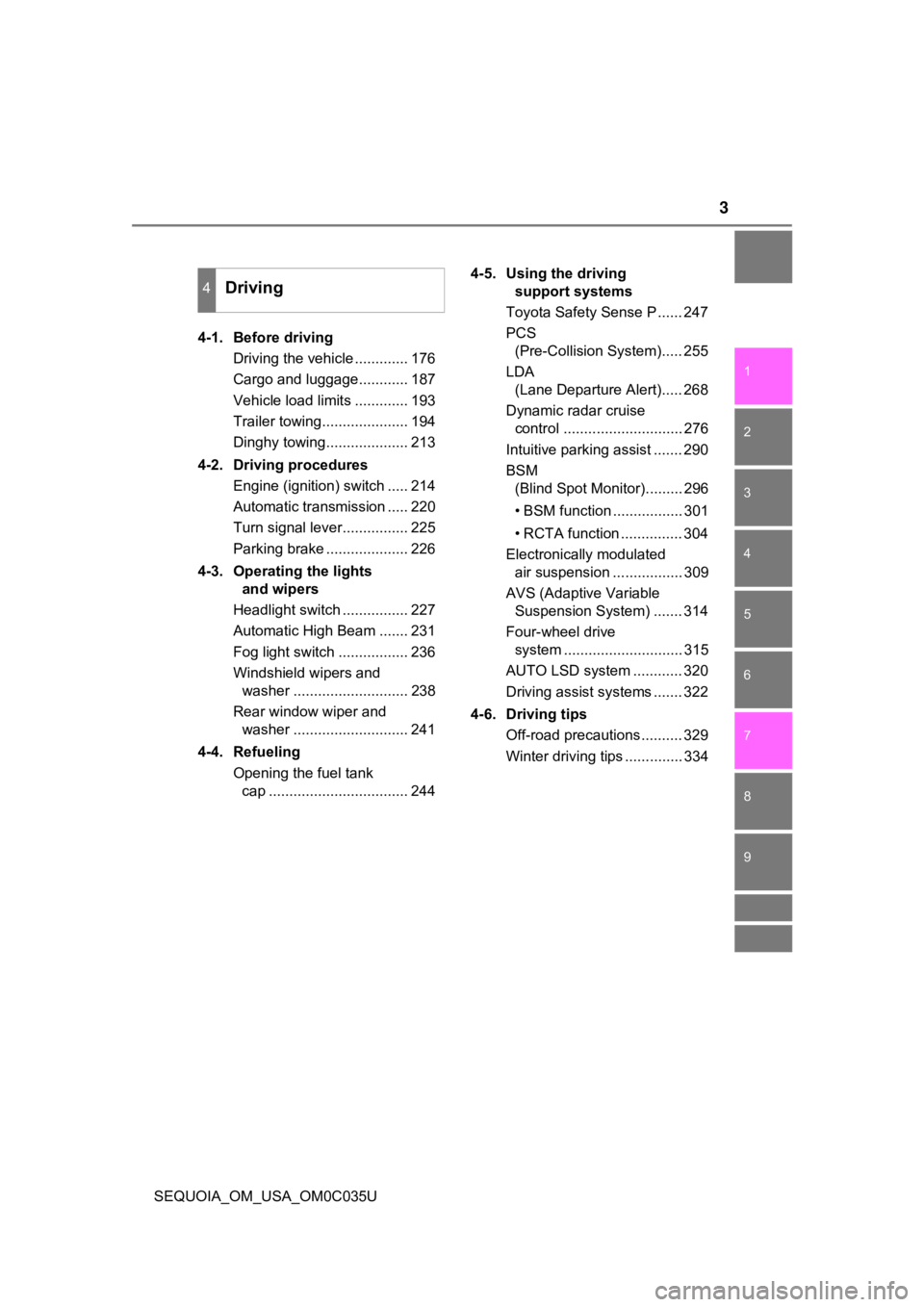
3
1
8 7
6
5
4
3
2
9
SEQUOIA_OM_USA_OM0C035U4-1. Before driving
Driving the vehicle ............. 176
Cargo and luggage............ 187
Vehicle load limits ............. 193
Trailer towing..................... 194
Dinghy towing.................... 213
4-2. Driving procedures Engine (ignition) switch ..... 214
Automatic transmission ..... 220
Turn signal lever................ 225
Parking brake .................... 226
4-3. Operating the lights and wipers
Headlight switch ................ 227
Automatic High Beam ....... 231
Fog light switch ................. 236
Windshield wipers and washer ............................ 238
Rear window wiper and washer ............................ 241
4-4. Refueling Opening the fuel tank cap .................................. 244 4-5. Using the driving
support systems
Toyota Safety Sense P ...... 247
PCS (Pre-Collision System)..... 255
LDA (Lane Departure Alert)..... 268
Dynamic radar cruise control ............................. 276
Intuitive parking assist ....... 290
BSM (Blind Spot Monitor)......... 296
• BSM function ................. 301
• RCTA function ............... 304
Electronically modulated air suspension ................. 309
AVS (Adaptive Variable Suspension System) ....... 314
Four-wheel drive system ............................. 315
AUTO LSD system ............ 320
Driving assist systems ....... 322
4-6. Driving tips Off-road precautions .......... 329
Winter driving tips .............. 334
4Driving
Page 5 of 588
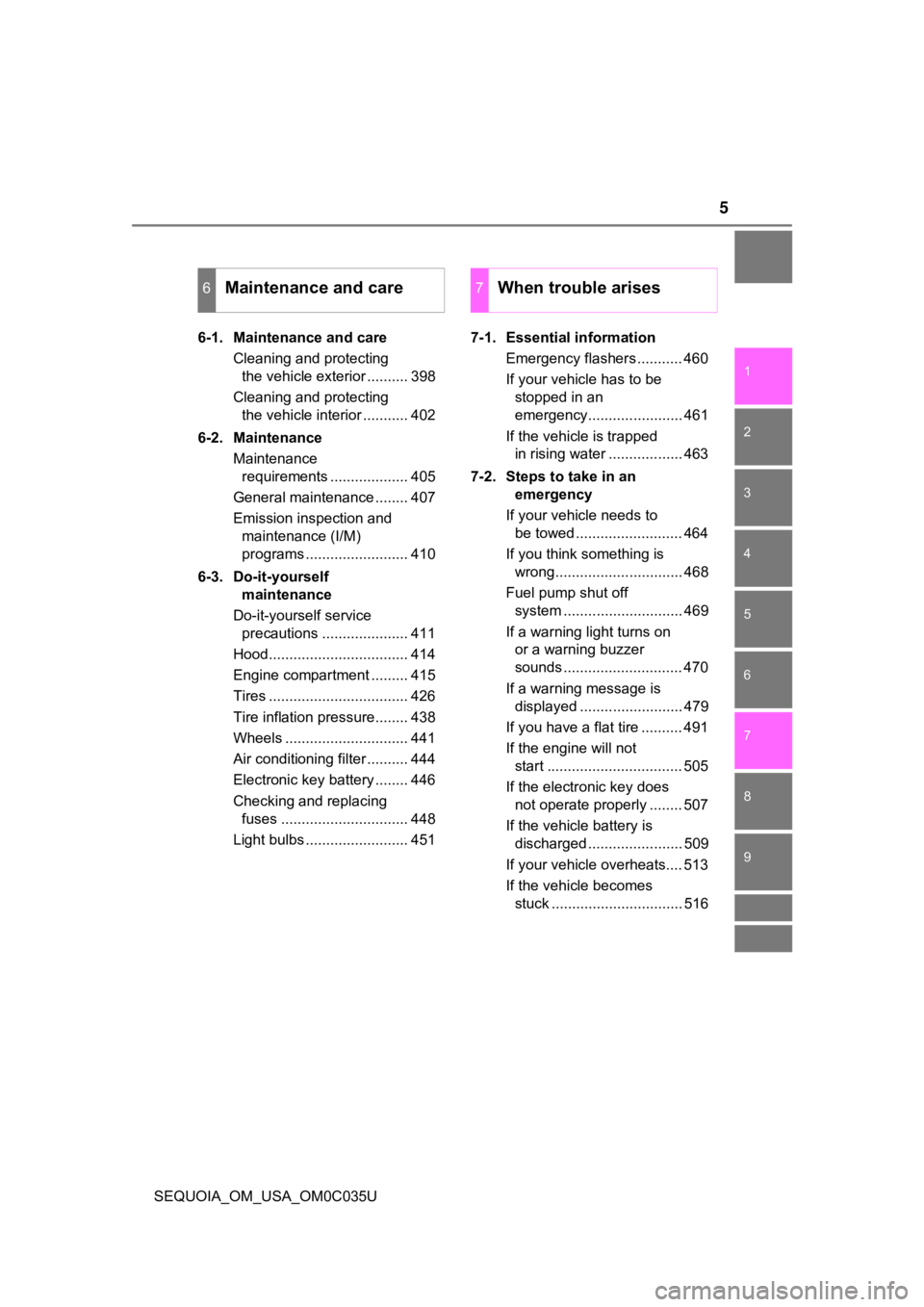
5
1
8 7
6
5
4
3
2
9
SEQUOIA_OM_USA_OM0C035U6-1. Maintenance and care
Cleaning and protecting the vehicle exterior .......... 398
Cleaning and protecting the vehicle interior ........... 402
6-2. Maintenance Maintenance requirements ................... 405
General maintenance ........ 407
Emission inspection and maintenance (I/M)
programs ......................... 410
6-3. Do-it-yourself maintenance
Do-it-yourself service precautions ..................... 411
Hood.................................. 414
Engine compartment ......... 415
Tires .................................. 426
Tire inflation pressure........ 438
Wheels .............................. 441
Air conditioning filter .......... 444
Electronic key battery ........ 446
Checking and replacing fuses ............................... 448
Light bulbs ......................... 451 7-1. Essential information
Emergency flashers ........... 460
If your vehicle has to be stopped in an
emergency....................... 461
If the vehicle is trapped in rising water .................. 463
7-2. Steps to take in an emergency
If your vehicle needs to be towed .......................... 464
If you think something is wrong............................... 468
Fuel pump shut off system ............................. 469
If a warning light turns on or a warning buzzer
sounds ............................. 470
If a warning message is displayed ......................... 479
If you have a flat tire .......... 491
If the engine will not start ................................. 505
If the electronic key does not operate properly ........ 507
If the vehicle battery is discharged ....................... 509
If your vehicle overheats.... 513
If the vehicle becomes stuck ................................ 516
6Maintenance and care7When trouble arises
Page 21 of 588
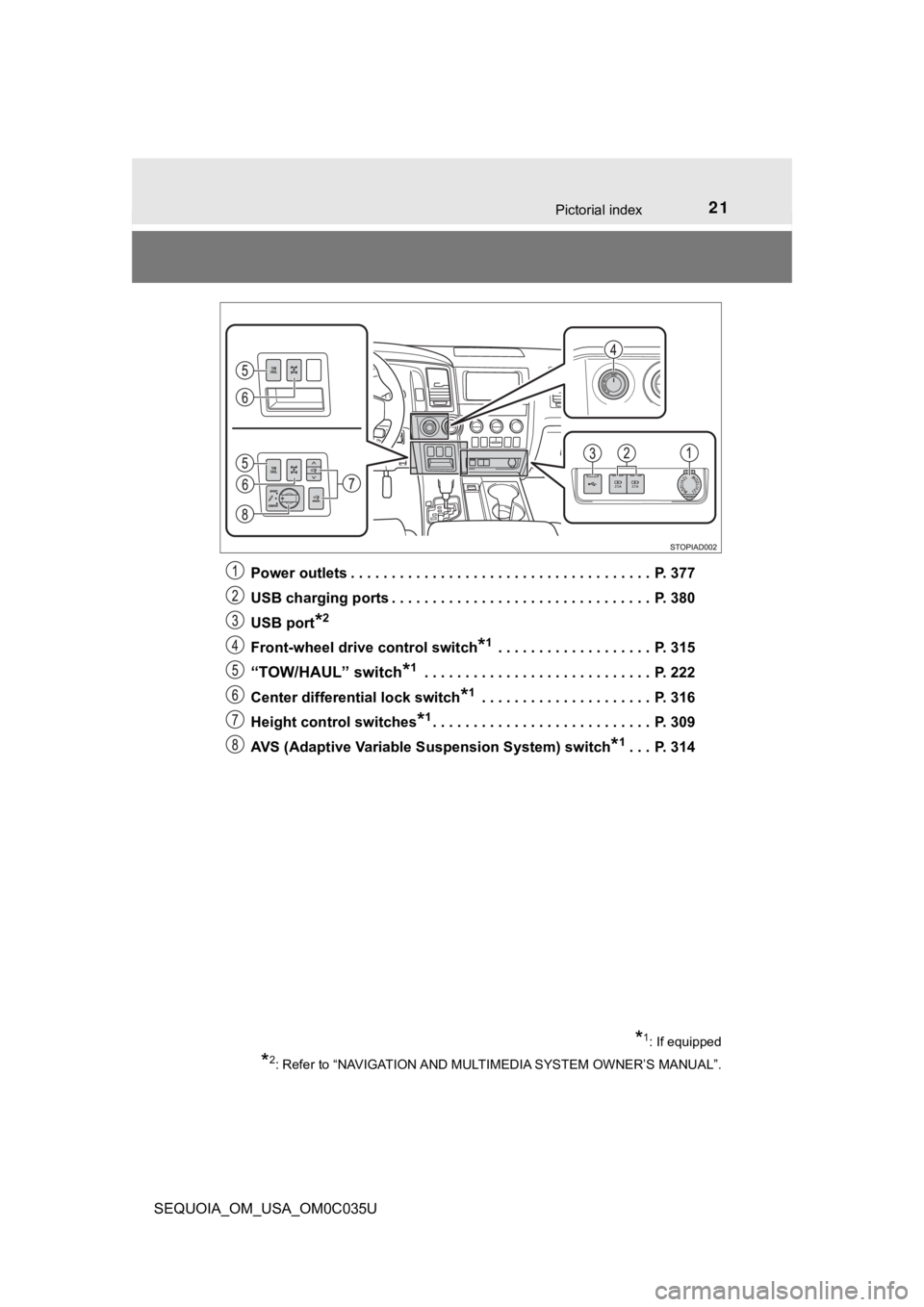
21Pictorial index
SEQUOIA_OM_USA_OM0C035UPower outlets . . . . . . . . . . . . . . . . . . . . . . . . . . . . . . . . . . . . . P. 377
USB charging ports . . . . . . . . . . . . . . . . . . . . . . . . . . . . . . . . P. 380
USB port
*2
Front-wheel drive
control switch*1 . . . . . . . . . . . . . . . . . . . P. 315
“TOW/HAUL” switch*1 . . . . . . . . . . . . . . . . . . . . . . . . . . . . P. 222
Center differential lock switch
*1 . . . . . . . . . . . . . . . . . . . . . P. 316
Height control switches
*1. . . . . . . . . . . . . . . . . . . . . . . . . . . P. 309
AVS (Adaptive Variable Suspension System) switch
*1. . . P. 314
*1: If equipped
*2: Refer to “NAVIGATION AND MULT IMEDIA SYSTEM OWNER’S MANUAL”.
Page 28 of 588
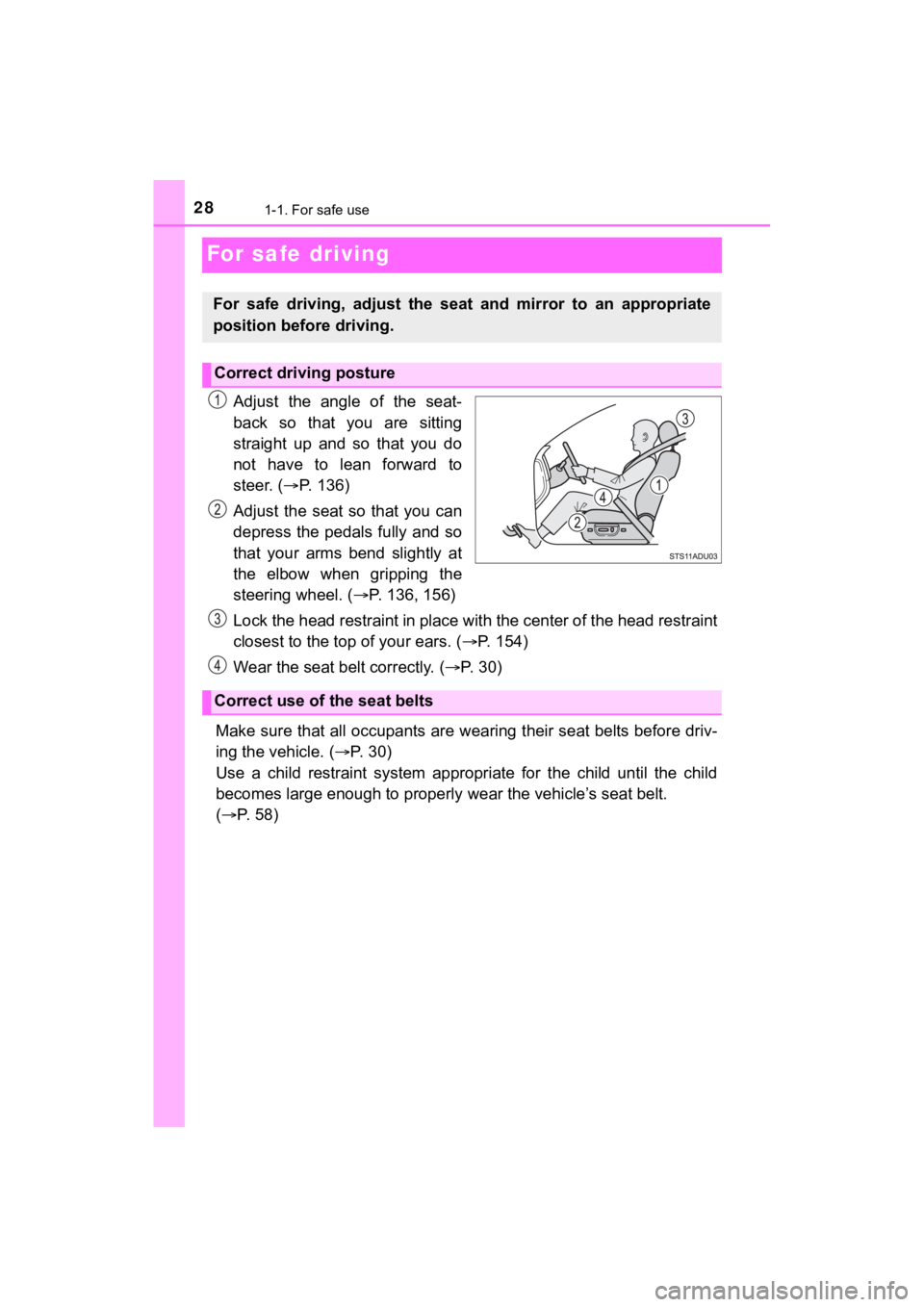
281-1. For safe use
SEQUOIA_OM_USA_OM0C035U
For safe driving
Adjust the angle of the seat-
back so that you are sitting
straight up and so that you do
not have to lean forward to
steer. (P. 1 3 6 )
Adjust the seat so that you can
depress the pedals fully and so
that your arms bend slightly at
the elbow when gripping the
steering wheel. ( P. 136, 156)
Lock the head restraint in place with the center of the head restraint
closest to the top of your ears. ( P. 1 5 4 )
Wear the seat belt correctly. ( P. 3 0 )
Make sure that all occupants are wearing their seat belts before driv-
ing the vehicle. ( P. 3 0 )
Use a child restraint system appropriate for the child until th e child
becomes large enough to properly wear the vehicle’s seat belt.
( P. 58)
For safe driving, adjust the seat and mirror to an appropriate
position before driving.
Correct driving posture
Correct use of the seat belts
Page 42 of 588

421-1. For safe use
SEQUOIA_OM_USA_OM0C035U
Your vehicle is equipped with ADVANCED AIRBAGS designed based
on the US motor vehicle safety standards (FMVSS208). The airbag
sensor assembly (ECU) controls airbag deployment based on infor-
mation obtained from the sensors etc. shown in the system compo -
nents diagram above. This informat ion includes crash severity and
occupant information. As the airbags deploy, a chemical reactio n in
the inflators quickly fills the airbags with non-toxic gas to h elp restrain
the motion of t he occupants.
WARNING
■SRS airbag precautions
Observe the following precautions regarding the SRS airbags.
Failure to do so may cause death or serious injury.
● The driver and all passengers in the vehicle must wear their se at belts
properly.
The SRS airbags are supplemental devices to be used with the se at belts.
● The SRS driver airbag deploys with considerable force, and can cause
death or serious injury especially if the driver is very close to the airbag.
The National Highway Traffic Safety Administration (NHTSA) advi ses:
Since the risk zone for the driver’s airbag is the first 2 - 3 in. (50 - 75 mm)
of inflation, placing yourself 10 in. (250 mm) from your driver airbag pro-
vides you with a clear margin of safety. This distance is measured from
the center of the steering wheel to your breastbone. If you sit less than
10 in. (250 mm) away now, you can change your driving position i n sev-
eral ways:
• Move your seat to the rear as far as you can while still reach ing the ped-
als comfortably.
• Slightly recline the back of the seat.
Although vehicle designs vary, many drivers can achieve the 10 in.
(250 mm) distance, even with the driver seat all the way forward , simply
by reclining the back of the seat somewhat. If reclining the ba ck of your
seat makes it hard to see the road, raise yourself by using a f irm, non-
slippery cushion, or raise the seat if your vehicle has that feature.
• If your steering wheel is adjustable, tilt it downward. This points the air-
bag toward your chest instead of your head and neck.
The seat should be adjusted as recommended by NHTSA above, whil e
still maintaining control of the foot pedals, steering wheel, and your view
of the instrument panel controls.
Page 44 of 588
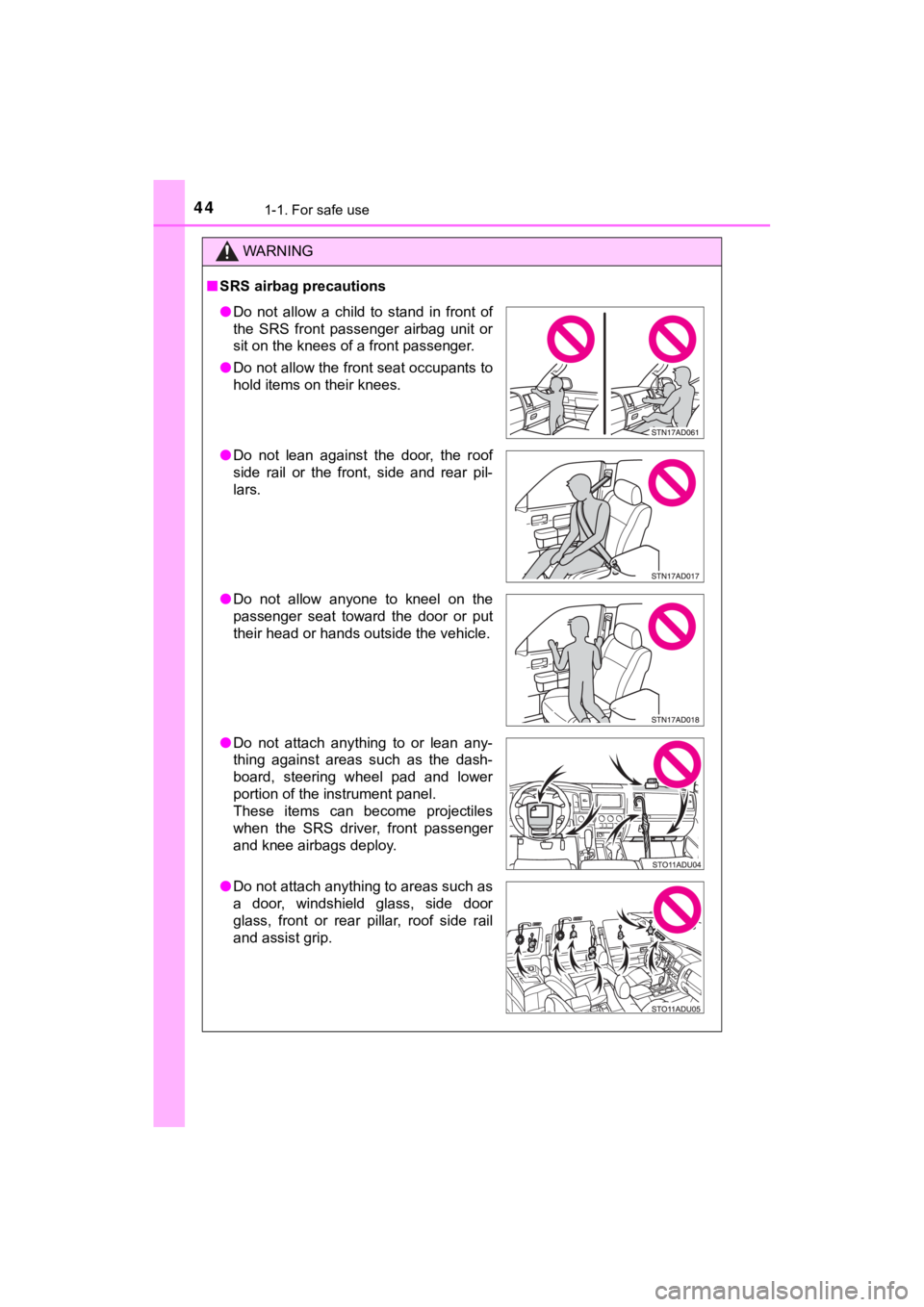
441-1. For safe use
SEQUOIA_OM_USA_OM0C035U
WARNING
■SRS airbag precautions
● Do not allow a child to stand in front of
the SRS front passenger airbag unit or
sit on the knees of a front passenger.
● Do not allow the front seat occupants to
hold items on their knees.
● Do not lean against the door, the roof
side rail or the front, side and rear pil-
lars.
● Do not allow anyone to kneel on the
passenger seat toward the door or put
their head or hands outside the vehicle.
● Do not attach anything to or lean any-
thing against areas such as the dash-
board, steering wheel pad and lower
portion of the instrument panel.
These items can become projectiles
when the SRS driver, front passenger
and knee airbags deploy.
● Do not attach anything to areas such as
a door, windshield glass, side door
glass, front or rear pillar, roof side rail
and assist grip.
Page 45 of 588

451-1. For safe use
1
For safety and security
SEQUOIA_OM_USA_OM0C035U
WARNING
■SRS airbag precautions
● Do not hang coat hangers or other hard objects on the coat hook s. All of
these items could become projectiles and may cause death or ser ious
injury, should the SRS curtain shield airbags deploy.
● If a vinyl cover is put on the area where the SRS knee airbag w ill deploy,
be sure to remove it.
● Do not use seat accessories which cover the parts where the SRS side
airbags inflate as they may interfere with inflation of the SRS airbags.
Such accessories may prevent the side airbags from activating c orrectly,
disable the system or cause the side airbags to inflate acciden tally, result-
ing in death or serious injury.
● Do not strike or apply significant levels of force to the area of the SRS air-
bag components.
Doing so can cause the SRS airbags to malfunction.
● Do not touch any of the component parts immediately after the S RS air-
bags have deployed (inflated) as they may be hot.
● If breathing becomes difficult after the SRS airbags have deplo yed, open a
door or window to allow fresh air in, or leave the vehicle if i t is safe to do
so. Wash off any residue as soon as possible to prevent skin ir ritation.
● If the areas where the SRS airbags are stored, such as the steering wheel
pad and front and rear pillar garnishes, are damaged or cracked , have
them replaced by your Toyota dealer.
● Do not place anything, such as a cushion, on the front passenger’s seat.
Doing so will disperse the passenger’s weight, which prevents t he sensor
from detecting the passenger’s weight properly. As a result, th e SRS front
airbags for the front passenger may not deploy in the event of a collision.
Page 46 of 588

461-1. For safe use
SEQUOIA_OM_USA_OM0C035U
■If the SRS airbags deploy (inflate)
●Slight abrasions, burns, bruising, etc., may be sustained from SRS airbags,
due to the extremely high speed deployment (inflation) by hot g ases.
● A loud noise and white powder will be emitted.
● Parts of the airbag module (steering wheel hub, airbag cover an d inflator) as
well as the front seats, parts of the front and rear pillars, and roof side rails,
may be hot for several minutes. The airbag itself may also be h ot.
● The windshield may crack.
● The emergency flashers will turn on automatically. (→P. 460)
● For Safety Connect subscribers, if any of the following situations occur, the
system is designed to send an emergency call to the response center, noti-
fying them of the vehicle’s location (without needing to push t he “SOS” but-
ton) and an agent will attempt to speak with the occupants to a scertain the
level of emergency and assistance required. If the occupants are unable to
communicate, the agent automatically treats the call as an emer gency and
helps to dispatch the necessary emergency services. (→P. 76)
• An SRS airbag is deployed.
• A seat belt pretensioner is activated.
• The vehicle is involved in a severe rear-end collision.
WARNING
■ Modification and disposal of SRS airbag system components
Do not dispose of your vehicle or perform any of the following modifications
without consulting your Toyota dealer. The SRS airbags may malfunction or
deploy (inflate) accidentally, causing death or serious injury.
● Installation, removal, disassembly and repair of the SRS airbag s
● Repairs, modifications, removal or replacement of the steering wheel,
instrument panel, dashboard, seats or seat upholstery, front, s ide and rear
pillars or roof side rails
● Repairs or modifications of the front fender, front bumper, or side of the
occupant compartment
● Installation of a grille guard (bull bars, kangaroo bar, etc.), snow plows,
winches or roof luggage carrier.
● Modifications to the vehicle’s suspension system
● Installation of electronic devices such as mobile two-way radio s and CD
players
● Modifications to your vehicle for a person with a physical disa bility
Page 50 of 588
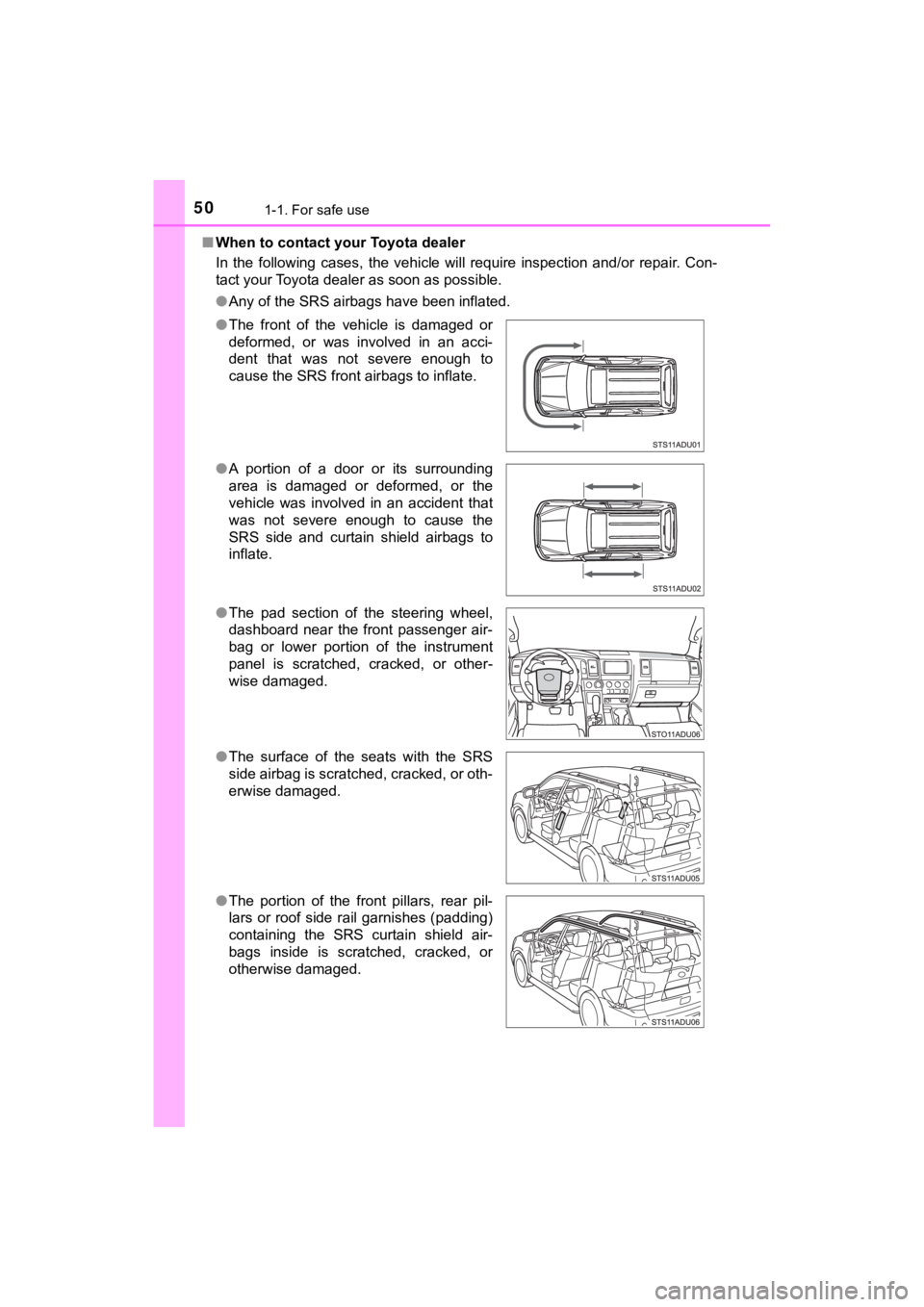
501-1. For safe use
SEQUOIA_OM_USA_OM0C035U■
When to contact your Toyota dealer
In the following cases, the vehicle will require inspection and/or repair. Con-
tact your Toyota dealer as soon as possible.
●Any of the SRS airbags have been inflated.
● The front of the vehicle is damaged or
deformed, or was involved in an acci-
dent that was not severe enough to
cause the SRS front airbags to inflate.
● A portion of a door or its surrounding
area is damaged or deformed, or the
vehicle was involved in an accident that
was not severe enough to cause the
SRS side and curtain shield airbags to
inflate.
● The pad section of the steering wheel,
dashboard near the front passenger air-
bag or lower portion of the instrument
panel is scratched, cracked, or other-
wise damaged.
● The surface of the seats with the SRS
side airbag is scratched, cracked, or oth-
erwise damaged.
● The portion of the front pillars, rear pil-
lars or roof side rail garnishes (padding)
containing the SRS curtain shield air-
bags inside is scratched, cracked, or
otherwise damaged.